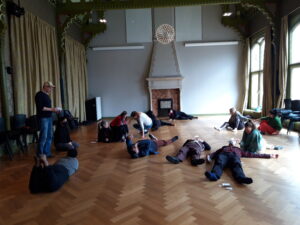Walking and Encountering:
Building Embodied Connections
by Myrskyryhmä – The Tempest Group (Elli Isokoski and Pauliina Laukkanen)
In Short:
This exercise guides the participant into an embodied experiencing of self with others. It creates and supports an embodied connection between participants.
Set-Up:
Large open space, group of participants.
Timeframe:
Approximately 30 minutes. Before the start of the exercise it is good to do something that allows the participants to explore and feel their own embodied existence before turning towards others.
Participants:
The whole group together.
Process:
Part 1: Preparation
- Music playing in the background – maybe something with soft rhythm yet flowing and gentle.
- Everyone walking around in the space, trying to fill the whole space and going to different locations (avoiding everyone walking in a circle in the same direction).
- Encounters: when you come across someone, pause for a moment together in order to have different encounters (some options for encounters listed in Part 2). Make a mental note of how long it feels good to stay with the encounter, then continue walking when you feel it is time to move on.
Part 2: Encounters
- Standing opposite and seeing each other
- Raised arms meeting / connecting (between elbow and wrist, this was a Covid-safe choice).
- Feet meeting.
- Side by side, shoulders / upper arms meeting.
- Open meeting: create a way to meet, either by taking one of the earlier options or creating new one.
- A dance of some kind can emerge in the meetings, with participants being mindful to find it together, not with one leading too much at the expense of the other.
- There can be several individual meetings of each kind before continuing on to other kinds of encounters.
- One is always free to walk around a bit more and to choose their encounters and their duration, all the while staying respectful to the experiences of others.
Part 3: Discussion
- Groups of three, including teachers.
- Talk about your experiences, giving space for each to share their thoughts.
- Possible considerations:
- What kinds of encounters did you experience?
Principle:
Encountering another person through connecting to each other in different embodied ways brings in playfulness, non-verbal communication and bodily knowledge. It is vital for each participant to have the freedom to define the duration and quality of their encounters, as this supports a sense of safety.
Variations:
Different kinds of encounters can be introduced. The above are just a few options. For example, a handshake is a familiar way of encountering people and a good gateway for the exercise, but during the Covid circumstances this was not the safest option.
Connection to PIMDI:
Exploring different ways of encountering others who are different from me and who approach the encounter in their own way. Something new and unexpected can happen when staying open to differences and having the choice to find your own ways of encountering each time. Multiple encounters.

